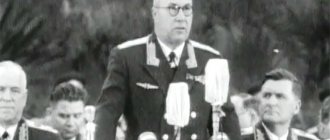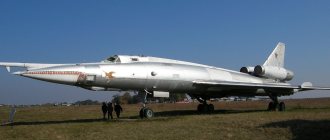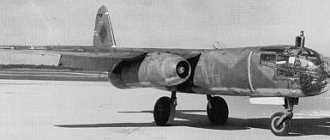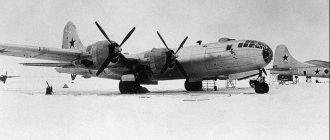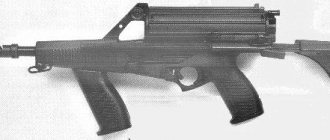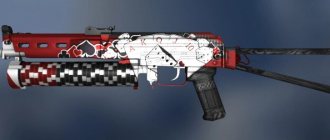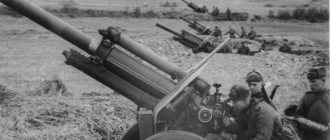Strategic jet bomber M-4 "Bison"
M-4 is a Soviet strategic jet bomber (according to NATO classification - Bison), and is the first in the world to enter service with the troops. Work on its creation was carried out simultaneously with the Tu-95, while the M-4 strategist differed from it in its higher flight speed but shorter range. A total of 34 aircraft were built, including 2 prototypes. Based on the M-4 bomber, the 3M bomber was created, which had an increased flight range; external differences between these two aircraft were minimal.
The reason for starting work on the M-4 bomber was the fact that at the very beginning of the nuclear confrontation between the 2 superpowers, circumstances were clearly not in favor of the USSR. Having developed its nuclear bomb 4 years after the Americans, the USSR was not only inferior in size to its existing nuclear arsenal, but also did not have the means of delivering “weapons of retaliation” to enemy territory. To do this, it was urgently necessary to create a fleet of strategic bombers that were able to solve this problem.
Since the aircraft was supposed to deliver a multi-ton bomb to the territory of a potential enemy, the basis of the technical specifications for the new aircraft was the flight range - at the level of 12,000 km. and the maximum combat load, which would be at least 5000 kg, is exactly how much the very first Soviet special ammunition RDS-1 weighed. Considering that the basis of air defense at that time was fighters, the new aircraft had to accelerate to 900-950 km/h and fly at an altitude of 12-13 km, which would allow the aircraft to escape pursuit. Of course, the possibility of the bomber being intercepted was not completely ruled out, so another point in the terms of reference was to equip the aircraft with sufficiently powerful defensive weapons. It was assumed that the aircraft could be used at any time of the day and in any weather with targeted bombing above the edge of the clouds. Especially for it, they were going to build new airfields with concrete runways 3-5 km long. and a width of 50-100 m.
This is exactly how an eight-seater cantilever all-metal midplane, equipped with 4 engines and a retractable bicycle-type chassis, was born. The strategic bomber was developed at OKB-23 under the leadership of V. M. Myasishchev. Its prototype first flew on January 20, 1953, the crew of the aircraft was led by test pilot V. Opadchiy. The construction of prototypes and serial production of the aircraft was carried out from 1954 to 1963 at plant No. 23 in Fili, where 93 M-4 and 3M aircraft of various modifications were manufactured.
The M-4 bomber was an all-metal monoplane of the classical design. The semi-monocoque fuselage had a circular cross-section with a diameter of 3.5 m and a length of 45.6 m and was technologically divided into 3 parts: the bow with the front pressurized cabin, the middle part, which included the wing center section, and the tail with the aft cabin. The crew was located in the front pressurized cabin, weapons control devices and basic flight and navigation equipment were installed. In the middle part of the fuselage there were: niches for cleaning the main landing gear, a bomb bay, lower and upper rifle installations, oxygen, fire-fighting and other equipment, as well as a container for rescue boats. There were 14 soft fuel tanks in the landing gear compartments, in the center section and under it, while 2 more tanks could be additionally hung in the bomb bay. In the tail section there were 6 more fuel tanks, as well as photographic equipment, shell boxes for the aft gun mount, a signal compartment, jamming equipment and a braking parachute. The aft pressurized cabin housed the aft gunner, who controlled the tail gun mount.
The airframes of all aircraft in the series were made of aluminum alloys. The bomber's wing sweep angle was 35.5 degrees. The aircraft crew was in two pressurized cabins: the bow cabin (2 pilots, a navigator, 2 gunners, a gunner-radio operator, and on the M-4 also a radar operator) and the aft cabin (tail gunner). All members of the plane's crew were in ejection seats, which made it possible to leave the plane in an emergency through 5 fuselage hatches. All 8 crew members ejected down in case of emergency. At various times, the M-4 strategic bomber used the AM-3A turbojet engine with a thrust of 8700 kgf, the AM-3D - 8750 kgf, the RD-3M-500 - 9500 kgf, or the RD-3M-500A - 10,500 kgf. The bombers were equipped with an in-flight refueling system.
In the design of the M-4, for the first time for aircraft of this class, a number of new materials were used, primarily the high-strength aluminum alloys B-95 and B-65. With the same specific gravity as D16T, they had increased strength, but at the same time greater rigidity and, as a consequence, worse fatigue characteristics of the material. During a typical flight lasting 15 hours, the bomber could accumulate more than 2.5 thousand wing “swings” - loading cycles. On a number of aircraft that were designed using these types of alloys, fatigue failure of structural components was the cause of many serious accidents, but Myasishchev managed to create an aircraft with a sufficient service life, which was later confirmed by practice.
The design of the M-4 bomber landing gear became a rather difficult problem. After working through a number of options, the choice was made on a “bicycle” scheme, little studied at that time, with two main supports, which were equipped with four-wheeled carts. To ensure stability while moving around the airfield, special small supporting supports were used, mounted on the wingtips of the bomber. The main reason for choosing this design was the significant weight gain compared to a traditional tricycle chassis and layout considerations.
Previously, in the Soviet Union, such a scheme was used only on the experimental I-211 fighter designed by Alekseev. This machine flew successfully, but its tests confirmed that it was difficult for the aircraft to raise its nose during takeoff. A way out of the situation was found in a rather original solution. The M-4 bomber began its take-off run with a parking angle; as the speed of the vehicle increased, the lifting force of the wing gradually compensated for the weight of the aircraft, and the pressure in a special hydraulic cylinder of the nose landing gear squeezed the rod, which turned the trolley so that it touched the ground only with the rear pair of wheels (mechanism "rearing") As a result of this, the nose of the M-4 rose, creating the necessary take-off angle, and the plane took off from the runway, almost without participation from the pilot.
A feature of the M-4 strategic bomber was a large-panel assembly aimed at reducing weight and the so-called “aerodynamically clean” wing (it lacked engines and nacelles for the landing gear). The consequence of using this arrangement was the “bicycle landing gear”, which made landing the aircraft unusually difficult. In addition, this scheme made it impossible to use external slings and modernize bomb bays. Thus, the Tsar Bomba charge was dropped from a Tu-95 bomber due to the impossibility of delivering it by M-4 aircraft.
Caring about saving the weight of the aircraft, the designers did not skimp on sufficiently powerful weapons. The range of offensive weapons, in addition to nuclear weapons, included ordinary free-falling bombs with a caliber of 500 to 9000 kg, torpedoes, sea mines, and UAB-2000F guided bombs. The maximum combat load of the M-18 was 24 tons. The aircraft's defensive armament included 3 double-barreled 23-mm remote-controlled cannon installations, which had spherical fire. At the same time, on the Tu-95 bomber there was a dead zone in the lower part of the front hemisphere. The American B-52 bomber generally made do with only one machine gun mount, located in the stern, since it was assumed that the probability of a high-speed bomber attacking the front hemisphere was close to 0.
The tactics for using the M-4 included its flight along a route in formation as part of a squadron or regiment at altitudes of 8-11 km. The planes had to repel attacks by enemy fighters in close cooperation. It was assumed that the bomber's cannon armament system would make it possible to effectively counter interceptor aircraft armed with 12.7 mm machine guns and rocket launchers with a launch range of up to 1 km. The route to the target was laid out bypassing enemy air defense airfields. Directly in the target area, the bombers destroyed the formation, and each aircraft carried out an attack on its own target. The return to base was carried out along the shortest route, since it was assumed that after the use of nuclear weapons, the control of the enemy’s air defense forces would be disrupted, which would allow the aircraft to overcome the most dangerous areas with minimal losses.
In the event that the target was outside the range of the aircraft (and there were a huge number of these objects), an option was considered in which the M-4 did not return to its base, but went out to a given area of the ocean, where the bomber crew left the plane and waited on inflatable boats until a Soviet submarine picks him up. It was assumed that even 1 dropped atomic bomb would justify this “consumable” method.
Flight characteristics of the M-4:
Dimensions: wingspan - 50.53 m, length - 47.67 m, height - 14.1 m. Wing area - 326.53 sq. m. The normal take-off weight of the aircraft is 138,500 kg, the maximum take-off weight is 181,500 kg. Power plant – 4 AM-3 turbojet engines, thrust – 4 x 8750 kgf. Maximum speed – 947 km/h. Practical flight range is 8,100 km. Service ceiling – 11,000 m. Crew – 8 people. Armament: 3 double-barreled 23-mm AM-23 cannon mounts in the lower, upper and aft parts of the fuselage. Combat load: normal 5,000 kg, maximum 24,000 kg.
Sources of information: -https://www.airwar.ru/enc/bomber/m4.html -https://www.dogswar.ru/voennaia-aviaciia/samolety/5319-strategicheskii-bomb.html -https:// www.airbase.ru/hangar/planes/russia/m/3m -https://ru.wikipedia.org/wiki
Print version Material posted by: Oleg Valetsky Date of publication: 10/20/2016
A sufficient number of articles have been written about the shortcomings of the M-16 automatic rifle itself, including from the experience of the Vietnam War. But the M-4 carbine (which has become the main small arms of the US Army since the mid-90s of the 20th century), created on the basis of this automatic rifle, had almost the same shortcomings.
Unlike the M-4, created for the military, the M-4 for civilian use does not have the ability to fire automatically.
In Iraq and Afghanistan, such a “civilian” version with a barrel length of 14.5 inches was used, which was produced under license from Colt by DPMS, American Spirit, Smith and Wesson, Bushmaster and some others.
Such a carbine was in service with PMC employees, including those who carried out combat missions in the interests of the US Army - they trained army and police units in Iraq and Afghanistan, provided security for military bases, escorted convoys and so-called “PSD tasks” for the transfer and protection "clients".
Therefore, M-4 carbines were certified by the Pentagon and the US Army commands in Afghanistan and Iraq for use in such conditions, and PMC personnel were trained according to US Army rules.
The carbine had high accuracy of fire, due to the design itself, which ensured a straight-line stroke of the bolt in the bolt frame. It also had a high muzzle velocity, as well as good quality chrome plating on the barrel and high-quality internal threading.
At the same time, due to the design of the bolt frame and gas tube, it was very sensitive to the ingress of not only dirt or sand (a very common “phenomenon” in Iraq and Afghanistan, in contrast to training grounds for “practical shooting”), but also in the event of a large the amount of carbon deposits inside the bolt frame, which made it difficult to move the bolt with the impact needle, and this often happened if it was not possible to immediately clean the weapon after firing, or if an excessively large number of cartridges were fired from it, which is typical for the weapons of an ordinary infantry shooter.
As a matter of fact, there was never any secret in this, because it was obvious that the bolt, running in the bolt frame with minimal clearance, would become contaminated with particles of powder emissions, and as a result, the bolt, without going through its full stroke, would not be able to properly capture the cartridge case with the ejector . At the same time, the cartridge case itself can only be removed with a ramrod from the side of the barrel, which led to stops in firing after a dozen magazines were fired, while misalignment of cartridges in Iraqi conditions occurred frequently - already on the second or third magazine fired.
During the war in Afghanistan, evidence from US Army personnel appeared in the American press about how unreliable the M-4 carbine is in combat. Thus, in the article “In 2008 Afghanistan firefight, US weapons failed” by the Mail Times author Richard Lardner dated October 12, 2009, an example was given of the battle on July 13, 2008 in Afghanistan, where the Americans suffered serious losses due to weapons failures.
Similar examples were given in other articles. For example, shortcomings were noted in the article by Slobodan Lekic “American rifles are not suitable for the Afghan mountains” from the May 21, 2010 issue of the Huffington Post newspaper (“US Rifles Not Suited For Warfare In Afghan Hills”), “Has the prestige of the American weapons in Afghanistan? Fox News in a report dated December 11, 2009 (“Did Weapons Fail US Troops During Afghanistan Assault?”), “M-16 rifle and M-4 carbine—time for change?” Charlie Cutshaw (Charlie Cutshaw) in the American military magazine "Defense Review" in the issue dated December 22, 2007 ("M16 Rifle and M4 Carbine: Time For a Change"), "Negative practices for operating the M-4 carbine in dusty conditions" by Christian Lowe in the American military online magazine “Military.com” dated December 18, 2007 (“M4 Carbine Fares Poorly in Dust Test”) and many others.
In the US Special Operations Command back in 2001, according to the article “The Heir on the Approach” by Alexander Mutavdzhich (“The Heir in the Grind” Aleksandar Mutawiћ.”Arsenal”-“Odbrana”. Broj 14 od 02/15/2008) in issue 16 of the almanac “ Arsenal" of the magazine "Odbrana" (Serbia) dated April 15, 2008, a review was made of the shortcomings of the M-4 carbine, and it was indicated that the M-4 is an "outdated operational system" with large disadvantages (shortened barrel and gas cylinder), with frequent distortions cartridges when discarding them.
Several modifications were created for the Special Operations Command, such as a shortened version of the Mk 18 CQBR (Close Quarters Battle Receiver), as well as modifications of the M-16 rifle in the sniper version - Mk 12 SPR (Special Purpose Receiver). However, the fundamental shortcomings themselves remained the same.
According to the article “The Heir is Approaching” by Alexander Mutavdzhich (“The Heir to the Grind” Aleksandar Mutawij. “Arsenal” - “Odbrana”. Broj 14 od 15/02/2008) in issue 14 of the almanac “Arsenal” of the magazine “Odbrana” (Serbia) dated On April 15, 2008, it was indicated that during comparative tests in the United States at the Aberdeen training ground back in 2007, after six thousand shots, if the new American Mk-16 rifle had only 226 stops, and the German HK-416 had 233 stops, then the M-4 carbine had 882 such stops.
It is for this reason that the Belgian company FNH (Fabrique Nationale de Herstal) developed the SCAR (Special Forces Combat Assault Rifle) rifle in two modifications - SCAR-L or Mk 16 Mod 0 caliber 5.56×45 and SCAR-H or Mk 17 Mod 0, caliber 7.62x51 mm with a set of barrels of various lengths.
In addition, the special operations command purchased German HK-416 assault rifles for its Delta detachment and the naval special forces team, and the USSOCOM special operations command adopted the SOCOM and SOCOM-2 carbines, created on the basis of the old American M1A1 caliber rifle 7.62/51 mm.
It is unlikely that all these small arms systems would have been created if the M-4 had met the stated characteristics. Of course, the rifle is excellent for shooting at ranges and competitions, and Colt led a skillful campaign in advertising its product.
However, the extent to which this rifle meets the assigned tasks has long been debated in the United States, and the above-mentioned article by Alexander Mutavdzhich is only a presentation of the point of view of American experts, citing specific evidence from American soldiers with experience in operations in Iraq and Afghanistan, as well as the activities of the Army Times magazine ”, the organization of American veterans “Soldiers for the Truth” and US Senator Tom Coburn, who began an investigation into Colt’s activities due to such low performance of the M-4 in battle.
Based on the experience of comparative shooting from the M-4 and from the AK, one can easily conclude that compared to the AK, the M-4 carbine is a much less reliable weapon. Without denying its higher shooting accuracy, it should be remembered that the M-4 is not a sporting weapon or a sniper rifle, but an individual weapon for the infantryman. Therefore, it must meet the standards that are defined for infantry weapons. Such a weapon simply cannot be sensitive to battle conditions, and even more absurd is the requirement for careful selection of ammunition for it, which in combat conditions is only possible for snipers, and even then not always and not for everyone. Of course, individual batches of ammunition are often rejected by the troops themselves, but differences in the quality of ammunition approved for use may affect accuracy, but not reliability.
The M-4 itself is, of course, a more accurate weapon than the AK, and the role of corrections when firing from it at short and medium distances plays a lesser role than when firing from an AK. However, the M-4 assumes a different battle tactics, perhaps familiar to the Americans: with an emphasis on the leading role in determining the development of the battle of fire support means, when only after the suppression of the enemy in certain areas, infantry, reinforced with armored vehicles, was brought into battle, whereas in Russia, as however, in Germany, since the First World War, the line of development of the battle was determined by the infantry, located in the first echelon, and depending on the needs of which the fire support means operated.
Marshal M.N. Tukhachevsky wrote about this issue in the magazine “Revolution and War” dated 1923, No. 21 (“Selected works”, in 2 volumes - M.: Military Publishing House, 1964), reviewing Russian tactics, German and French troops in the First World War. Obviously, the American troops, due to the very nature of the wars in which they participated, developed a different tactic, which led to the appearance of the M-16/M-4.
Again due to this, not a single American ally, including the Croatian army and the army of Bosnia and Herzegovina, was willing to buy either the M-16 or M-4 rifles, and the army of Bosnia and Herzegovina was only in order after the end of the war in 1995 US humanitarian aid and received M-16 rifles.
As for the Russian Federation, when evaluating the M-4 and AKM, there is a mixture of different combat missions - training shooters for medium distances and training attack aircraft for close combat. Initially, both in the Wehrmacht and in the Red Army, these two tasks were different, and if for the bulk of the infantry the main weapons were considered carbines, rifles and heavy machine guns, then for the assault units, as well as for the scouts marching in reconnaissance patrols, machine guns were considered the main weapons and hand grenades with cover from light machine guns. In this case, the problem was that shooting training was often supervised by snipers, whose principle was maximum accuracy - and this is where the motto arose - “if I don’t see, I don’t shoot.” However, when storming trenches, as well as when conducting reconnaissance in mountainous and urban areas, this principle did not work and could not work. In the end, the PPSh and PPS assault rifles differed in tasks from the Mosin rifle, Simonov and Mauser carbine. In the same way, the German assault rifle models MP 38, MP 38/40, MP 40, as well as the StG 44 assault rifle and the Italian Beretta M38A/42 submachine gun had different tasks from the Mauser Gewehr 98 rifle.
All this is quite easily understood by participants in combat operations, based on the elementary characteristics of the human psyche and vision, according to which the defender is in an advantageous position over the attacker in terms of the ability to conduct aimed fire. In order to neutralize this advantage, fire trimming of both artillery and aviation, as well as other support means, is used.
The fighters themselves, the first to storm a trench or building, or walking in the lead patrol, in order to protect themselves from aimed shots from the enemy, fire automatically, throw hand grenades with the main goal of destabilizing the enemy and preventing him from shooting accurately and hitting him. Only then do these fighters or the fighters from the cover group following them conduct targeted fire from sniper rifles, machine guns and grenade launchers, use demolition charges with incendiary tubes to destroy the enemy, or call in the fire of fire support means.
In general, these are simple and in some ways even elementary things, to understand which you just need to have experience in performing assault and reconnaissance missions in war.
But nowadays, the organization of shooting training in many armies suffers from formalism, therefore, with the outbreak of certain “local” wars, it turns out that local militants are better prepared for battle than professional military personnel.
Particularly indicative here are the constant comparisons of the M-70 and other AKM models with the American M-4 carbine, which has different capabilities and different combat missions.
Since, unlike the M-4, it is impossible to shoot just as accurately from the AKM at medium distances, and when passing the standards intended for the M-4, it is inferior in accuracy to the latter, the AKM itself is declared a low-quality weapon. It is not surprising that some of those who visited Iraq and Afghanistan in various private companies did not understand that the AKM is a different type of weapon. As a result, people who were not too burdened with participating in wars began to spread clichés in their interviews about the superiority of the M-4 over the AKM.
Oleg Valetsky
M-4 carbine
Soldiers must take care of their M4 themselves
We bring to your attention a translation of a Washington Times article dated February 19, 2014, indicating that the m4 carbine, which US Army soldiers received in 1994, is far from being as reliable, accurate and effective as is commonly believed. So, the original article is called...
The content of the article
Soldiers must fend for themselves after US Army warns about defects in M4 carbine
Ruston Kramer, a senior warrant officer with 20 years in the Green Berets, has learned for himself that if you want to improve your chances of survival, modify the M4 carbine yourself, the main small arms weapon of the US Army.
Warrant Officer Kramer found himself in the thick of some of the world's fiercest battles against terrorism, from hunting fanatics in the mountains of northern Iraq to intercepting opium suppliers in the deserts of southern Afghanistan. He was awarded the Silver Star for his bravery during Operation Viking Hammer for the destruction of the terrorist group Ansar al-Islam in Iraq.
The Warrant Officer says he and his friends in the special forces have learned a trick to maintaining the M4A1 - they break the established rules, buy third-party triggers and modify their weapons.
“It’s not particularly reliable,” Warrant Officer Kramer says of the standard carbine. “I would rather use something else. If I could have picked something else, I would have.”
Documents obtained by the Washington Times show that the Pentagon was warned before the wars in Afghanistan and Iraq that variations of the M4 carbine were flawed and could jam or misfire, especially in the difficult desert conditions that plagued both wars.
The US Special Operations Command released a classified report in 2001 that found the m4A1 to be almost entirely defective because the weapon jammed when attempting to fire automatically or rapidly.
In 2002, an internal Picatinny Arsenal report claimed that the M4A1 was prone to overheating and "catastrophically jamming in the barrel."
The test results also had implications for the Army. Since 2002, the troops have had many conventional light-barreled M4s, of which 500,000 ended up in the wars in Iraq and Afghanistan. The m4, like the m4A1, should have been able to fire at the same rate.
, which lost exclusive rights to the M4 design in 2009, stubbornly continued to defend the carbine. Another manufacturer received a contract for the supply of carbines last year.
did not respond to requests for comment
The manufacturer's website states that “in today's world, the reliability, accuracy and rate of fire of the Colt m4 carbines provide coalition forces with everything they need to accomplish any mission. The M4 provides easy mobility, on-target speed and firepower. The carbine has earned its credibility in many combat operations around the world, which speaks for itself and proves the carbine’s leadership position in the weapons world.”
The monopoly on the main military weapons ended in February 2013, when a contract was concluded with FN Herstal, a worldwide weapons manufacturer with a plant in South Carolina.
Colt did a good job. Since the mid-1990s, the US Army has spent $600 million on more than half a million carbines.
Critics argue that the reports from Special Forces and Army commanders should have encouraged the Army to look for a better design at the beginning of the century. The Army tweaked the carbine from time to time, but total improvements weren't made until senators put pressure on it years later.
In 2011, a decade after the 9/11 terrorist attacks, the Army announced it was redesigning the M4 as a commando version with a heavy barrel and automatic trigger.
Some of the problems exposed in 2001 and 2002, such as delays and wedges, have become more apparent, most notoriously in the Battle of Wanat in Afghanistan in 2008, which killed nine US Army soldiers.
“Essentially speaking, there were unnecessary losses due to flaws in the weapon,” says Scott Traudt, who advised the Army on improving the M4 a decade ago.
Today he is a consultant for a competitor and manufacturer of a new carbine that is planned to be sold to equip special forces.
Replacement with SCAR
In an independent survey of soldiers returning from Iraq and Afghanistan, 20% reported that the M4 jammed in combat, and of those, one-fifth considered the delays a “major hindrance.”
Faced with inaction from the Pentagon, soldiers like Warrant Officer Kramer took matters into their own hands, even at the risk of upsetting the established order.
“You can make some improvements to your weapon to take its reliability to the next level. Although we are not allowed to change anything in our weapons, obviously some guys, including me, went for it, we added something to increase reliability,” he says, “it’s better to stand in court than to lie 2 meters underground ."
There have been complaints about the M4 for at least three reasons: short firing range, low stopping power of ammunition, and the need for constant maintenance - cleaning and lubrication - in sandy conditions, otherwise the carbine is prone to jamming. Soldiers also complained that the magazine easily wrinkled and the springs broke.
The short-barreled weapon was suitable for house-to-house fighting in Iraq. But in Afghanistan, a lack of range meant the Taliban could operate from safe distances.
S. Traudt claims that there were also combat malfunctions of the M4, which were kept silent. The failure of the M4s at Wanat was not known to the public until Army historians chronicled the battle and published a popularization of it in 2010. Even arms procurement officials said they had not heard about these problems until the press covered the army story.
There was no detailed study of the M4 by any regulatory body - despite the fact that the weapon is the most important attribute of an infantryman. Congress's audit agency, the Government Accountability Office, has not looked at the M4 since it entered service in the mid-1990s. Likewise, the Pentagon did not conduct experimental shooting of the M4 or M4A1 “commando”.
Alarmed by the 2001 test, the Special Operations Forces developed their own weapon, the SCAR - Special Operations Forces Assault Rifle, and armed it with Army Rangers, Green Berets and SEALs. Delta Force, the Army's elite anti-terrorism unit, has purchased a German-designed carbine. Sources say the SOF is not entirely happy with the replacement and still relies on the M4A1.
“The 5.56mm SCAR was a mistake from the boys' point of view,” says Ryan Zinke, a former member of Team 6, the SEALs' elite anti-terrorism unit.
Questionable standard
The Iraqi-Afghanistan history of the M4 Carbine is replete with dubious tales of satisfied soldiers who took the M4 to war. The M4 is a lightweight version of the M16 for short ranges and, judging by numerous surveys and reviews, is very popular among the military.
The Times approached two Special Forces soldiers who noted shortcomings but expressed a fondness for the weapon.
“The reality is that for all armies, their governments cannot order the perfect assault weapon. This is simply unacceptable for the price,” says the Green Beret, who did not want to speak on the record. “For its price, I think the M4 is an amazing weapon. From M16 to M4, I have been dealing with weapons of this family for almost thirty years and would not trade them for anything.”
A Marine who served in Afghanistan praises the M4, but notes that it needs constant cleaning and lubrication, or becomes vulnerable to wedges. “The first thing you do when you get back to camp is clean your weapons,” he says.
R. Zinke, a former SEAL, says the M4A1 has been improved and its shortcomings addressed.
“The M4 has become the standard special forces weapon,” says Zinke. “The mounting rail has been greatly improved and easily accommodates optics, illumination and sights. The cartridge provides an acceptable combination of range and firepower. The variety of ammunition also improved flexibility."
S. Traudt says his company was paid ten years ago for suggestions on how to improve the M4. A report was prepared on extending the life of the barrel and improving operational reliability.
“The M4 was almost standard,” he says, “the Army paid us to find a way to improve it inexpensively with a small amount of additional engineering and metalwork to make the carbine noticeably more reliable than the Colt weapon. The army received our advice and did not follow it.”
"He's almost useless"
Retired Major General Robert Scales, an artillery officer who received a Silver Star in Vietnam, is an outspoken critic of the M4.
He says the 5.56mm bullet is too small and the gas system is prone to lag. He claims that Kalashnikov's G36 and AK-74 use much better designs.
“To be honest, the whole thing is a scandal,” says General Scales. “We send soldiers into close combat with lousy weapons, we've been doing this since World War II, and no one gives a damn. This is a national problem."
“It has no penetration power,” he says of the M4. “It is ineffective against transport, against fortifications. It is ineffective against almost anything except a person in open space. Put body armor on an enemy and the M4 is almost useless."
The Army believes that critics like General Scales have been answered with the "environmentally friendly" lead-free M885A1 ammunition, introduced into service in 2010. It has more penetrating power and a longer effective range.
General Scales also questions why the Army only has one carbine model.
“More soldiers are killed by light weapons than in sea and air combat,” he says. “There is a significant difference between knocking down doors in Baghdad and fighting in the open, flat areas of Afghanistan. In one case, lightness and maneuver are required, in the other, a heavy bullet and a long range.”
In 2009, in the eighth year of the war, an army officer wrote a study on this topic.
“Open source reports from Afghanistan since 2001 have revealed that soldiers are encountering enemies at ranges ranging from nose-to-nose to beyond the effective range of the M4,” wrote Maj. Thomas Earhart, then attending the Fort Leavenworth Military Graduate School. "Many comments focus on the soldier's ability to hit the target or the bullet's inability to achieve the desired effect."
He summarized his findings by concluding that the M4 is not the best weapon for America's longest war: “Operations in Afghanistan often require infantry to engage the enemy beyond 300 meters. Although the infantryman is ideally equipped for combat in Afghanistan, his current weaponry, doctrine, and marksmanship training do not provide the ability to accurately fire to kill out to 500 meters and are therefore unacceptable.”
Feedback on problem testing
The second coming of the M4 in the military was in 2000, when the Special Operations Command, in conjunction with the Marine Command, provided a comprehensive review of the heavy-barreled M4A1. They had no idea then that they were testing critical weapons in 2 upcoming ground wars.
With SEALs and Green Berets in mind, testers subjected the carbine to constant, barrel-melting fire in harsh conditions such as those found in Iraq and Afghanistan.
A secret SOF study called the M4A1 carbine “inherently flawed.” During the firing, the bolt opened and tried to eject the cartridge case, which was clamped in the chamber by the pressure created by the fired cartridge. The weapons could be maintained at an “acceptable level of reliability” if they were subject to “intensive care,” the report said.
The study also noted the M4A1's "disturbing shortcomings when operating in austere environments under intense fire." Six reasons were given, including a lack of spare parts and "failure to control quality during mass production."
The report said that at a meeting of the joint special operations forces - SEALs, Rangers and Delta Force - the soldiers "identified several shortcomings in the m4A1, including reliability, safety and accuracy."
Barrels can become loose and "become inaccurate."
However, Special Operations Command said the M4A1 "virtually meets the needs of Army users."
Months later, the Army Institute of Weapons Technology, originally the Armament Technology Facility, part of the Picatinny Arsenal, undertook its own study of the M4A1.
A 2002 report sent by the head of the institute to the Special Operations Forces Command spoke of “reliability problems associated with non-extraction and non-ejection of casings, breakdowns of valves, failures in arctic and coastal (in the tidal zone, swimming on the surface and under it) conditions " says a copy obtained by the Times.
“The M4A1 also suffered from premature ammunition explosion after a relatively small amount of ammunition was fired at a high rate,” it said. “Catastrophic barrel problems have also occurred after relatively few rounds of ammunition were fired.”
Preventing jamming
The Times asked special operations commanders why they continue to supply M4A1s to troops.
“The M4A1 and M4 carbines have served us well through more than a decade of war,” says Capt. Kevin Andahl. “The Army has made significant improvements to the M4A1/M4 over the past twelve years. A heavy barrel was developed and put into production in 2002. In addition, the M4 and M4A1 received improvements to the trigger, extractor spring, recoil buffer, chamber, magazine, and bolt. These revisions were aimed at issues raised by the 2002 report."
Capt. Andahl said the command voluntarily changed a number of parts to "improve the M4A1's suitability for Special Operations Command in urban and indoor combat environments."
The same year that Picatinny Arsenal joined history, the Marines undertook their test of the original M4. The main weapon of the Marine was then and is now the long-range, heavy-barreled M16.
The Army Times later reported that "the M4 suffers three times the firing delays of the M16A4."
According to S. Traudt and other critics of the M4, the tests should have prompted the Army to rethink what carbine design to send across the ocean.
S. Traudt says he thought the jamming problems encountered by a significant portion of troops over the past decade could be avoided with the use of a product reliability improvement kit.
The kit was tested at the Naval Weapons Center in 2001 and at the Picatinny Arsenal in 2002. This included replacing the extractor spring, ejector spring, gas tube, and gas piston with more heat-resistant ones, and moving to a "one-piece, four-coil" system designed with more heat-resistant materials to improve the weapon's performance.
“An M4A1 equipped with these parts will fire magazine after magazine in automatic mode until its barrel evaporates,” says S. Traudt. “In our tests, the M4A1 barrel failed after 1,375 rounds. The typical military M4A1 fails after 840 rounds fired, due to its technologically obsolete parts, and usually it is not even a barrel failure. This is a gas system or valve failure.”
At the time of testing, internal reports from Special Operations Command and Picatinny Arsenal reported that the M4A1 was severely flawed and unsuitable for special operations.
One person on Capitol Hill took notice. In 2007, Tom Coburn, a senator from Oklahoma, began a campaign to find a new carbine for the Army.
“Given the long-term problems with the reliability and lethality of the M16 design, on which the M4 is based, I fear that our military does not have the best weapons,” he wrote in April 2007. “A number of manufacturers have developed and tested weapons that appear to provide a significantly better reliable alternative.”
For the next five years, the senator fought this battle alone. No other lawmaker joined him, but finally the Army was about to make a difference.
Rowan Scarborough
